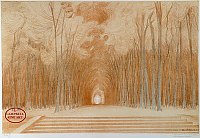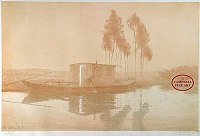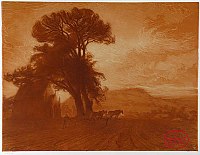 |
|
Charles Marie Dulac1865 - 1898 |
|
|
Click on a picture for more details |
|
|
The deeply spiritual Symbolist landscapes of Charles Dulac are some of the most emotive evocations of landscape to have been created in nineteenth-century colour lithography. Designed directly on the stones or zinc plates, these poetic images idealise nature without deforming it, reflecting the divine in landscape, to create a mystical experience unique to Charles Dulac’s works. All of Charles Dulac’s major original lithographs were designed within a period of only about three years, towards the end of the artist’s tragically short life. Born in Paris, Charles Dulac had been trained in decorative painting and as a scene painter for theatre and opera before turning to fine art. Around 1890 he fell ill with lead poisoning as a result of years spent in industrial studios working with lead-white pigment. The illness proved terminal and Charles Dulac died in 1898, at the age of 33. Upon discovering his fatal illness, Charles Dulac went through a conversion, a spiritual crisis, being moved by the example of Saint Francis of Assisi to join the Third Order of Saint Francis. He remained true to this religious calling to the moment of his death, being buried in his monk’s habit. The profound spiritual communion with nature which Dulac discovered upon his conversion is apparent throughout his art, for he was to devote himself to art for the remaining years of his short life. It was through the medium of colour lithography that Charles Dulac discovered his true genius. He saw his works in lithography as continuous experiments in the search for the fleeting emotions of nature, expressing the spiritual aspects of landscape. Charles Dulac printed each of his lithographs in carefully chosen schemes of delicate, muted colours, concentrating upon mood rather than detail. Eloquent and mysterious, these images take us through a series of emotions ranging from the uplifting and the beautiful to the sombre and the melancholy. Charles Marie Dulac issued only two major series of prints during his short life; the first, Suite de Paysages (1892/3), contained eight original lithographs and zincographs; the second, Le Cantique des Creatures of 1894, contained a further nine subjects and only three of his final series Credo, designed later the same year, were completed. For both of his published series, only a specific number of impressions were printed in each colour scheme, from each plate or stone, producing a total of 100 numbered impressions of each image. The stones or zinc plates were destroyed immediately after the first and only edition was printed. The works of Charles Dulac represent some of the most emotive and enigmatic interpretations of the religious aspects of landscape ever to have been produced through the medium of original colour lithography. [more] |





